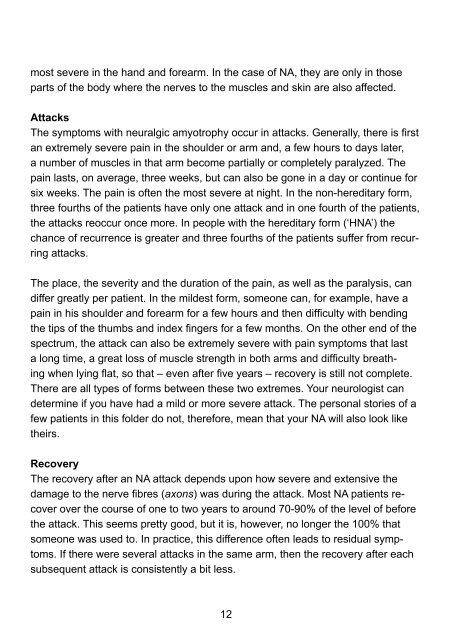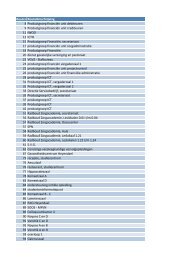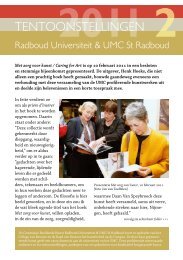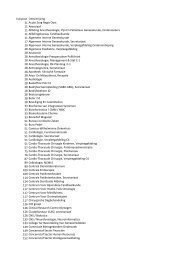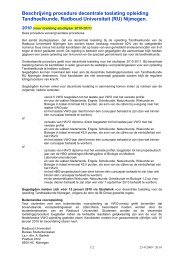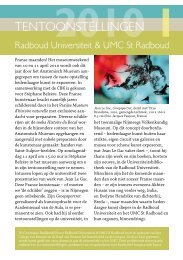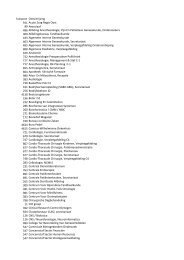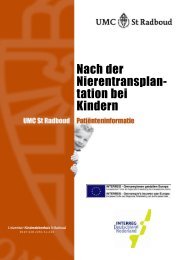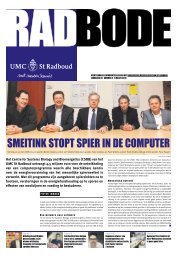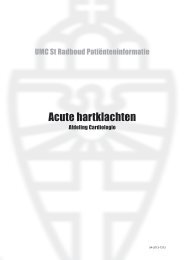Neuralgic Amyotrophy: idiopathic and hereditary ... - UMC St Radboud
Neuralgic Amyotrophy: idiopathic and hereditary ... - UMC St Radboud
Neuralgic Amyotrophy: idiopathic and hereditary ... - UMC St Radboud
You also want an ePaper? Increase the reach of your titles
YUMPU automatically turns print PDFs into web optimized ePapers that Google loves.
most severe in the h<strong>and</strong> <strong>and</strong> forearm. In the case of NA, they are only in those<br />
parts of the body where the nerves to the muscles <strong>and</strong> skin are also affected.<br />
Attacks<br />
The symptoms with neuralgic amyotrophy occur in attacks. Generally, there is first<br />
an extremely severe pain in the shoulder or arm <strong>and</strong>, a few hours to days later,<br />
a number of muscles in that arm become partially or completely paralyzed. The<br />
pain lasts, on average, three weeks, but can also be gone in a day or continue for<br />
six weeks. The pain is often the most severe at night. In the non-<strong>hereditary</strong> form,<br />
three fourths of the patients have only one attack <strong>and</strong> in one fourth of the patients,<br />
the attacks reoccur once more. In people with the <strong>hereditary</strong> form (‘HNA’) the<br />
chance of recurrence is greater <strong>and</strong> three fourths of the patients suffer from recurring<br />
attacks.<br />
The place, the severity <strong>and</strong> the duration of the pain, as well as the paralysis, can<br />
differ greatly per patient. In the mildest form, someone can, for example, have a<br />
pain in his shoulder <strong>and</strong> forearm for a few hours <strong>and</strong> then difficulty with bending<br />
the tips of the thumbs <strong>and</strong> index fingers for a few months. On the other end of the<br />
spectrum, the attack can also be extremely severe with pain symptoms that last<br />
a long time, a great loss of muscle strength in both arms <strong>and</strong> difficulty breathing<br />
when lying flat, so that – even after five years – recovery is still not complete.<br />
There are all types of forms between these two extremes. Your neurologist can<br />
determine if you have had a mild or more severe attack. The personal stories of a<br />
few patients in this folder do not, therefore, mean that your NA will also look like<br />
theirs.<br />
Recovery<br />
The recovery after an NA attack depends upon how severe <strong>and</strong> extensive the<br />
damage to the nerve fibres (axons) was during the attack. Most NA patients recover<br />
over the course of one to two years to around 70-90% of the level of before<br />
the attack. This seems pretty good, but it is, however, no longer the 100% that<br />
someone was used to. In practice, this difference often leads to residual symptoms.<br />
If there were several attacks in the same arm, then the recovery after each<br />
subsequent attack is consistently a bit less.<br />
12<br />
Your body always tries to repair the damaged nerves, but this goes very slowly.<br />
There are two ways in which the affected nerves can repair themselves:<br />
Taking over tasks<br />
If, within a nerve bundle, no more than two thirds of the axons are damaged, then<br />
the remaining axons will take over the work of the damaged cables within three<br />
to four months. This mechanism is called: ‘collateral reinnervation’. This repair<br />
mechanism works well because the muscle can then again be completely controlled.<br />
However, this is at the expense of some load endurance. That means that the<br />
muscle can certainly provide maximum strength once but cannot maintain it well<br />
or keep it up for long. In daily life, patients often notice that, after a time, they can,<br />
in principle, carry out all of the movements with the arm, but that the arm becomes<br />
heavy <strong>and</strong> tired after being used for awhile <strong>and</strong> they must stop <strong>and</strong> rest before<br />
they can continue with what they were doing.<br />
Nerve growth<br />
If, within the nerve bundle, more than two thirds of the axons are damaged, the<br />
remaining axons will no longer be able to take over all of the work of the damaged<br />
fibres. After a few months, there is still part of the muscle that is not yet<br />
connected to the nerve <strong>and</strong> which, therefore, has no strength. If this happens, the<br />
body still has two ways to repair the nerve whereby, from the tip of the damage,<br />
new axons in the neural tube grow towards the muscle. This process is called<br />
‘proximal reinnervation’ <strong>and</strong> is extremely slow: less than one centimetre per week.<br />
If, for example, the nerve that services the muscles in the thumb is damaged at<br />
the level of the armpit, it can take anywhere between eight months <strong>and</strong> four years<br />
before the new nerve fibres reach the thumb muscles. This is why the recovery<br />
of the partially paralyzed muscles with NA takes so long. That means that, even<br />
after two years, improvements in muscle strength can still occur, especially with<br />
the muscles that are the furthest away. Recovery, however, is generally not a<br />
complete then.<br />
If the nerve has been affected a number of times, the chance of recovery decreases.<br />
Also, nerves are not able to tolerate everything: If they become even more<br />
damaged, they will be ‘broken’ for good. In practice, this means that the function<br />
of, for example, the arm after an initial period of painful loss of function will still<br />
13


